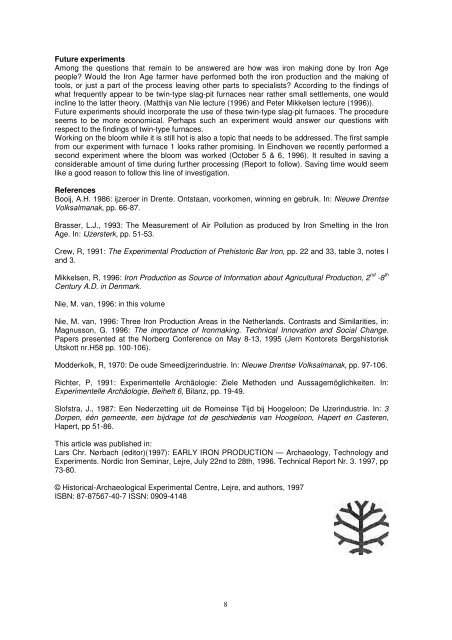1 Experiments with a slag-tapping and a slag pit furnace Anneke ...
1 Experiments with a slag-tapping and a slag pit furnace Anneke ...
1 Experiments with a slag-tapping and a slag pit furnace Anneke ...
Create successful ePaper yourself
Turn your PDF publications into a flip-book with our unique Google optimized e-Paper software.
Future experiments<br />
Among the questions that remain to be answered are how was iron making done by Iron Age<br />
people? Would the Iron Age farmer have performed both the iron production <strong>and</strong> the making of<br />
tools, or just a part of the process leaving other parts to specialists? According to the findings of<br />
what frequently appear to be twin-type <strong>slag</strong>-<strong>pit</strong> <strong>furnace</strong>s near rather small settlements, one would<br />
incline to the latter theory. (Matthijs van Nie lecture (1996) <strong>and</strong> Peter Mikkelsen lecture (1996)).<br />
Future experiments should incorporate the use of these twin-type <strong>slag</strong>-<strong>pit</strong> <strong>furnace</strong>s. The procedure<br />
seems to be more economical. Perhaps such an experiment would answer our questions <strong>with</strong><br />
respect to the findings of twin-type <strong>furnace</strong>s.<br />
Working on the bloom while it is still hot is also a topic that needs to be addressed. The first sample<br />
from our experiment <strong>with</strong> <strong>furnace</strong> 1 looks rather promising. In Eindhoven we recently performed a<br />
second experiment where the bloom was worked (October 5 & 6, 1996). It resulted in saving a<br />
considerable amount of time during further processing (Report to follow). Saving time would seem<br />
like a good reason to follow this line of investigation.<br />
References<br />
Booij, A.H. 1986: ijzeroer in Drente. Ontstaan, voorkomen, winning en gebruik. In: Nieuwe Drentse<br />
Volksalmanak, pp. 66-87.<br />
Brasser, L.J., 1993: The Measurement of Air Pollution as produced by Iron Smelting in the Iron<br />
Age. In: IJzersterk, pp. 51-53.<br />
Crew, R, 1991: The Experimental Production of Prehistoric Bar Iron, pp. 22 <strong>and</strong> 33, table 3, notes l<br />
<strong>and</strong> 3.<br />
Mikkelsen, R, 1996: Iron Production as Source of Information about Agricultural Production, 2 nd -8 th<br />
Century A.D. in Denmark.<br />
Nie, M. van, 1996: in this volume<br />
Nie, M. van, 1996: Three Iron Production Areas in the Netherl<strong>and</strong>s. Contrasts <strong>and</strong> Similarities, in:<br />
Magnusson, G. 1996: The importance of Ironmaking. Technical Innovation <strong>and</strong> Social Change.<br />
Papers presented at the Norberg Conference on May 8-13, 1995 (Jern Kontorets Bergshistorisk<br />
Utskott nr.H58 pp. 100-106).<br />
Modderkolk, R, 1970: De oude Smeedijzerindustrie. In: Nieuwe Drentse Volksalmanak, pp. 97-106.<br />
Richter, P, 1991: Experimentelle Archäologie: Ziele Methoden und Aussagemöglichkeiten. In:<br />
Experimentelle Archäologie, Beiheft 6, Bilanz, pp. 19-49.<br />
Slofstra, J., 1987: Een Nederzetting uit de Romeinse Tijd bij Hoogeloon; De IJzerindustrie. In: 3<br />
Dorpen, één gemeente, een bijdrage tot de geschiedenis van Hoogeloon, Hapert en Casteren,<br />
Hapert, pp 51-86.<br />
This article was published in:<br />
Lars Chr. Nørbach (editor)(1997): EARLY IRON PRODUCTION — Archaeology, Technology <strong>and</strong><br />
<strong>Experiments</strong>. Nordic Iron Seminar, Lejre, July 22nd to 28th, 1996. Technical Report Nr. 3. 1997, pp<br />
73-80.<br />
© Historical-Archaeological Experimental Centre, Lejre, <strong>and</strong> authors, 1997<br />
ISBN: 87-87567-40-7 ISSN: 0909-4148<br />
8


